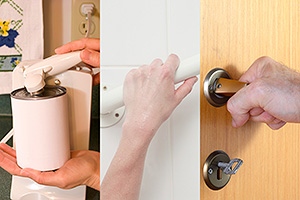Quick Tips: Modifying Your Home and Work Area When You Have Arthritis
Get started
The pain and stiffness from arthritis may make it hard for you to do your daily tasks. For instance, if you have problems with your hands or fingers, you may find it hard to type or to open and close a door. If you have problems with your hips or knees, it may be hard to go up and down stairs or get in and out of a chair.
When these everyday tasks get harder to do, you may feel tired and frustrated. But there are some changes you can make in your home and work area that can help you move more easily and with less pain.

At home
- Use doorknob covers to make opening doors easier. Or replace round doorknobs with handles that have a lever so you don’t have to use a whole grip to twist the doorknob open. You can just push down on the handle with your hand or even your elbow. This takes the strain off of your wrist and fingers.
- Use a reacher to pick up things off the floor or grab items that are high up in cabinets or closets.
- Use padded or large-handled tools to make objects such as keys, silverware, kitchen pots and pans, combs, and toothbrushes easier to hold.
- Use electric tools, such as can openers, blenders, and power tools, to make it easier to open cans, mix things, or do home repairs.
- Use higher chairs or seat cushions to avoid sitting in chairs that are very low and hard to get in and out of.
- Put a raised seat on your toilet to make it easier to sit down and stand up.
- Put grab bars in your bathroom to help you get in and out of the shower or tub. And put no-slip tape in the bathtub. All of these things can also help prevent falls.
- Use a tall stool for tasks that you would normally do standing up such as working in the kitchen or wood shop.
- Use buttonhooks, long-handled shoehorns, and sock pullers to make getting dressed easier. And use Velcro instead of small buttons or snaps on your clothes.
You can find some of these devices and tools online, in medical supply stores and catalogs, and in local retail and home improvement stores.
At work
- Use carts or carriers with wheels to move objects such as heavy boxes or furniture. If you can’t use these items all the time, learn to lift an object safely. Be sure to keep the object close to you as you lift it. Bend your knees and keep your back straight as you grasp the object, then straighten your knees to lift it up.
- Use an adjustable chair that supports your lower back and lets you adjust the height so your feet rest flat on the floor.
- Use a computer keyboard tray that is big enough to hold your keyboard and mouse. And be sure the height of the tray can be adjusted to a spot that allows you to type with no pain. There are other types of keyboards, including split or curved keyboards, that may work better for you.
- Use a computer trackball mouse or touch pad instead of a standard computer mouse to reduce strain on your hand, wrist, and shoulder.
- Adjust your computer monitor so that the top of the screen is at about eye level to reduce strain on your neck.
- Arrange your desk or work area so that the things you use the most are easy to reach and you don’t have to lean, bend, or twist to get them.
- Sit up straight to do your work, and take the stress off your back. Relax your shoulders, keep your feet flat on the floor, and don’t lean forward too much.
- Take breaks to stretch or get out of your chair. This can help keep your muscles loose and your joints moving well.
An occupational therapist can help you make these and other changes to your home and work area.
Current as of: April 1, 2019
Author: Healthwise Staff
Medical Review:Anne C. Poinier, MD – Internal Medicine & Martin J. Gabica, MD – Family Medicine & Kathleen Romito, MD – Family Medicine & Stanford M. Shoor, MD – Rheumatology
Topic Contents
This information does not replace the advice of a doctor. Healthwise, Incorporated, disclaims any warranty or liability for your use of this information. Your use of this information means that you agree to the Terms of Use. Learn how we develop our content.

